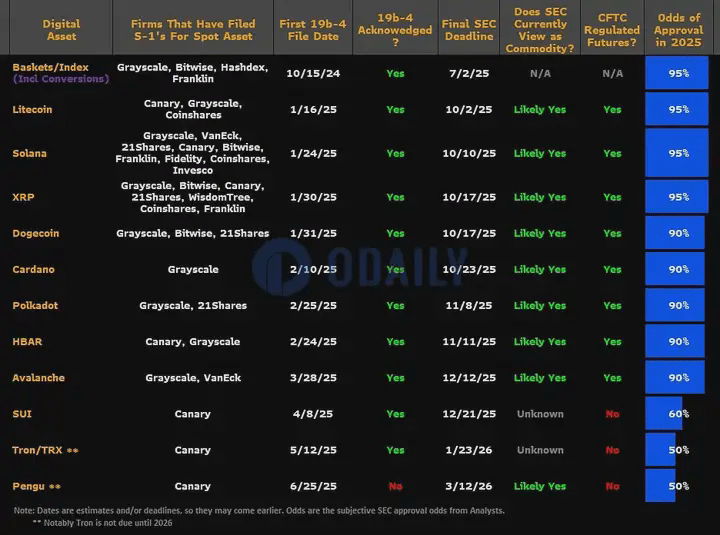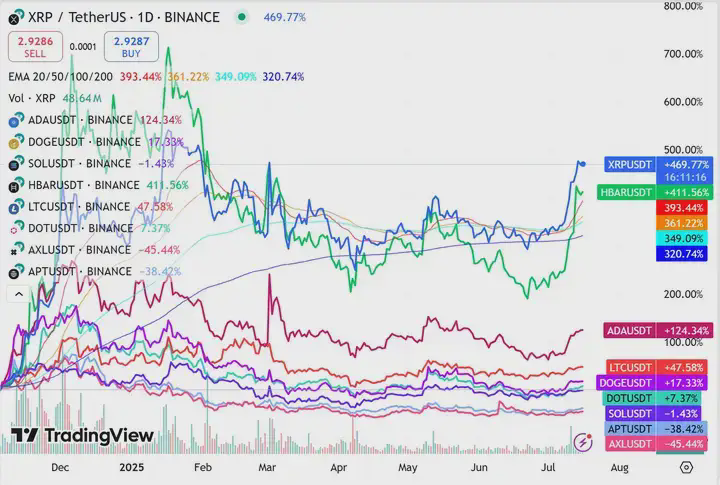As Bitcoin breaks through $120,000 and Ethereum reclaims $3,600, discussions about the return of altcoin season in the market are gradually heating up.
It remains uncertain whether the altcoin season has truly arrived, but if a new round of capital inflow begins, which investment opportunities should we focus on?
Unlike the past 'wild growth' driven by retail and speculative sentiment, institutional capital participation changes the ownership of market pricing power. Their capital scale is larger, investment logic is more rigorous, compliance, and fundamentals are emphasized more, and they possess stronger market influence. This means that sectors capable of attracting large institutional capital in the future are likely to become market hotspots.
Which coins can attract institutional interest?
Based on the trends of Bitcoin and Ethereum, tokens included in corporate balance sheets are more likely to become an important investment direction in this round of 'altcoin season.' Currently, listed companies have incorporated some mainstream altcoins into their asset reserves, including BNB, SOL, TRX, and HYPE.
BNB: As the core of the Binance ecosystem, BNB is backed by the largest exchange in global trading volume, providing strong cash flow support. Recently, Binance announced a settlement with U.S. regulators, further solidifying its compliance status.
SOL: Solana is known for its high-performance blockchain, with a significant advantage in meme trading and a relatively complete ecosystem. In 2024, the Solana Foundation is collaborating with multiple traditional financial institutions to explore the tokenization of RWA (real-world assets), attracting institutional capital attention. Recently, the rise of Letsbonk.fun has driven a surge in Solana trading volume, indicating a continuous increase in ecosystem activity. The SOL spot staking ETF has been approved, which may provide some reference for the launch of the spot SOL ETF, but specific developments still need to be observed in market and regulatory dynamics.
TRX: TRON has attracted a large amount of stablecoin trading with low costs and high throughput, with USDT accounting for over 50% on the TRON chain. In early 2025, TRON announced a collaboration with a Hong Kong fintech company to explore compliant stablecoin applications. Through a partnership with NASDAQ-listed SRM Entertainment (referred to as SRM), it is undergoing a reverse merger to achieve listing on mainstream U.S. capital markets.
HYPE: Unlike the aforementioned three assets that have gone through multiple market cycles, HYPE, as an emerging public chain token, has topped the on-chain contract throne due to the continuous increase in its derivatives trading volume. It is one of the few new projects that has demonstrated 'cash flow capability' in its early stages, with more detailed data to be provided in the DeFi section below.
ETF candidate sector: Which altcoins can institutions invest in?
Potential ETF candidate coins include: SOL, XRP, LTC, DOGE, ADA, DOT, HBAR, AXL, APT.
These cryptocurrencies are mostly large-cap public chain tokens. Although some of the coins have functions limited to trading mediums or units of account and gradually faded from market focus in the past, since the end of 2024, ETF-related positive news has re-attracted institutional and market attention.

If traditional spot SOL ETFs are approved in the future, it may further enhance their market appeal. A similar situation applies to XRP, as the New York Stock Exchange has already approved ProShares Ultra's futures-based XRP ETF, and the long regulatory dispute between Ripple Labs and the U.S. SEC may be concluding, making the approval probability of an XRP spot ETF very high this year. Moreover, from the price trend of XRP itself, it has maintained a resilient stance during multiple rounds of market corrections. The strong will continue to be strong, which has always been well-validated in the crypto space.

Additionally, LTC and HBAR have a higher probability of approval, and both are not marked as securities, with clear compliance attributes. HBAR has also shown strong resilience amid multiple market shocks.
RWA sector
Chainlink's decentralized oracle is a key infrastructure for many RWA projects. In 2024, Chainlink has partnered with several financial institutions, including Goldman Sachs, Morgan Stanley, and Wells Fargo, to provide data and settlement support for tokenized bonds and real estate asset tokenization.
RWA naturally aligns with institutional investment preferences, serving as a 'bridge sector' that combines real returns with compliance expectations. However, currently, the only protocols that have formed scale and issued tokens are Ondo (ONDO) and Centrifuge (CFG). Additionally, Chainlink (LINK), as an indispensable technological pillar of the RWA sector, is also worth paying attention to.
DeFi sector
As the Ethereum ecosystem continues to heat up, DeFi projects on it are most likely to benefit from the capital overflow effect. AAVE, as the leader in the lending sector, and UNI, as the leader in the DEX sector, may become the preferred choices for funds due to their mature ecological positions and stable revenue models. HYPE, as an emerging potential project (previously mentioned in the asset reserve sector), shows certain investment appeal due to its rapid growth in the derivatives trading field.
Stablecoin sector
The next wave of true adoption in cryptocurrencies may come from stablecoins and payments. With the introduction of the Genius Act, the regulatory framework for stablecoins is becoming increasingly clear.
The stablecoin sector usually forms a synergistic effect with the RWA and DeFi sectors. In the case of capital outflows and depreciation of protocol deposits in the DeFi sector, RWA and CDPs (Collateralized Debt Positions) have achieved significant growth in TVL.
In the stablecoin sector, centralized stablecoins like USDT and USDC dominate due to their dollar reserve anchoring and have a wide range of application scenarios. If decentralized stablecoins' governance tokens must be chosen as investment targets, options include MKR behind DAI or ENA behind USDe.
Sky (formerly MakerDAO) is the leader in the decentralized stablecoin field, maintaining a healthy financial status through investments in tokenized U.S. treasury bonds and exhibiting solid fundamentals. It is currently attempting to create its own ecological narrative through brand reconstruction.
Only coins with fundamentals, capable of telling a story, and can be caught by institutions are likely to navigate through the fog of valuation reconstruction in the upcoming cycle and become true winners.




